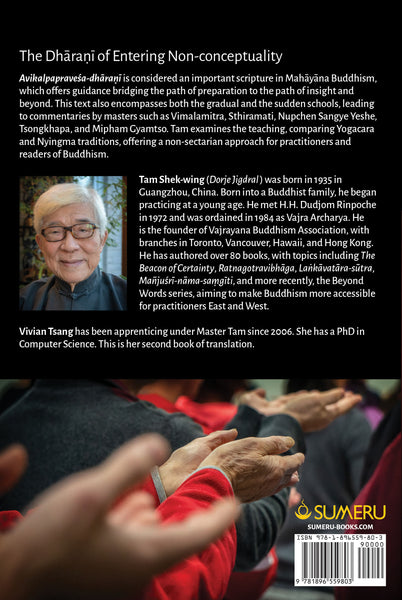The Dhāraṇī of Entering Non-conceptuality
The Dhāraṇī of Entering Non-conceptuality
ISBN 9781896559803 / 194 pages / 6.12" x 9.21" / Bibliography
English, Chinese and transliterated Tibetan / Published Nov 2021
Avikalpapraveśa-dhāraṇī is considered an important scripture in Mahāyāna Buddhism,which offers guidance bridging the path of preparation to the path of insight and beyond. This text also encompasses both the gradual and the sudden schools, leading to commentaries by masters such as Vimalamitra, Sthiramati, Nupchen Sangye Yeshe, Tsongkhapa, and Mipham Gyamtso. Tam examines the teaching, comparing Yogacara and Nyingma traditions, offering a non-sectarian approach for practitioners and readers of Buddhism.
Tam Shek-wing (Dorje Jigdral) was born in 1935 in Guangzhou, China. Born into a Buddhist family, he began practicing at a young age. He met H.H. Dudjom Rinpoche in 1972 and was ordained in 1984 as Vajra Archarya. He is the founder of Vajrayana Buddhism Association, with branches in Toronto, Vancouver, Hawaii, and Hong Kong. He has authored over 80 books, with topics including The Beacon of Certainty, Ratnagotravibhāga, Laṅkāvatāra-sūtra, Mañjuśrī-nāma-saṃgīti, and more recently, the Beyond Words series, aiming to make Buddhism more accessible for practitioners East and West.
Vivian Tsang has been apprenticing under Master Tam since 2006. She has a PhD in Computer Science. This is her second book of translation.
Contents
Translator’s Preface1 A Reader’s Guide to The Dhāraṇī of Entering into Non-conceptuality
I. Maitreya’s “Four Preparations Transcending Appearances”
II. Nāgārjuna’s Fourfold Dependent Arising
III. “Not Relinquishing the Remainder” and the Middle Way
IV. Tathāgatagarbha-Ālayavijñāna
V. The Topical Outline of Ārya-avikalpapraveśa-dhāraṇī
2 A Commentary on The Dhāraṇī of Entering into Non-conceptuality
The Setting
Abandoning the Conceptual Signs of What is to be Remedied
On Abandoning the Conceptual Signs of the Remedies
Abandoning the Conceptual Signs of the So-called Suchness
The Abandonment of Conceptual Signs of Wisdom Realization
The Stages of Entering Non-conceptuality
The Name of “Non-Conceptual” in the Non-Conceptual Realm
What is Non-conceptuality?
The Analogy of the Great Treasure
Explaining the Analogy
From Examining the Various Conceptions to Entering Non-conceptuality
The Principle of Entering Non-conceptual Illustrated Using Form
Generalizing the Example
The Coalescence of Consciousness and Wisdom
The Conclusion
3 “Entering Non-Conceptuality”: From Maitreya’s Yogācāra to Nyingma’s Practice and Realization
I. Maitreya’s Yogācāra
II. Four Phases of Relinquishment and Four Primary Preparations
III. The Meditation of Yogācāra
IV. The Nyingma PracticeV. On “Entering Non-Conceptuality”
VI. Remaining Issues
4 The Sanskrit and Tibetan Manuscripts, along with a Chinese Re-translation and its English Translation
A note on the translation
I. The Setting
II. Abandoning the Conceptual Signs of What is to be Remedied
III. On Abandoning the Conceptual Signs of the Remedies
IV. Abandoning the Conceptual Signs of the So-called Suchness
V. The Abandonment of Conceptual Signs of Wisdom Realization
VI. The Stages of Entering Non-conceptuality
VII. The Name of “Non-Conceptual” in the Non-Conceptual Realm
VIII. What is Non-conceptuality?
IX. The Analogy of the Great Treasure
X. Explaining the Analogy
XI. From Examining the Various Conceptions to Entering Non-conceptuality
XII. The Principle of Entering Non-conceptual As Illustrated Using Form
XIII. Generalizing the Example
XIV. The Coalescence of Consciousness and Wisdom
XV. The Conclusion
References







